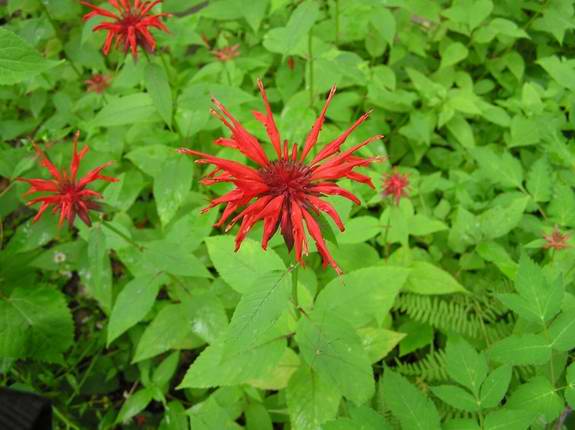|
Return to Hiker's Notebook Home Page
Common Name: Bee Balm, Oswego tea, Bergamot, Fragrant balm, Crimson beebalm, Scarlet Monarda, Mountain mint, Indian plume - Balm is from the Latin balsamum which was the name given the balsam tree from which a pleasant smelling resin was derived; it came to refer to any aromatic ointment, especially one with palliative properties. The plant was used by Native Americans in the treatment of a wide range of maladies; the name bee balm refers to its use as a topical remedy for bee stings.
Scientific Name: Monarda didyma - Nicolas Monardes first described many American flora in a series of books published between 1565 and 1574 that were translated into English as "Joyfull Newes out of the New Found Worlde." He was one of the most distinguished Spanish physicians of the era and specialized in the healing power of native plants that "bring such present remedie for all diseases, as may seeme altogether incredible." The genus Monarda is named in his honor. The species name is from didymos, from the Greek dyo meaning twin or paired; this refers to the fact that there are two stamens on each flower.
The many names of M. didyma are evidence of an enduring cultural association with both Native Americans and the subsequent European colonists. The cluster of red tubular flowers are arrayed in an irregular whorled configuration that has the chaotic appearance of an coruscating starburst. The color is variously described as crimson, red or scarlet but is its own unique "wood red" hue; it evolved to attract the hummingbirds whose long proboscises can recover the nectar from the bottom of the long flowers while at the same time spreading the pollen necessary for fertilization. The common name Bee Balm is a misnomer if it is construed to imply that bees visit the plant to collect nectar, a virtual impossibility in consideration of the structure of the flower.
The name Oswego Tea has an interesting etymology that is subject to speculation as to its origins. John Bartram was a noted naturalist, purportedly the Father of American Botany and a confidant of Benjamin Franklin. He was one of the founding members of the American Philosophical Society. Appointed by the British crown to be a member of a latter day fact-finding commission, he visited the tribes of the League of the Six Nations (Iroquois Confederacy) and explored the area around Lake Ontario in 1743. It was during this sojourn that he is alleged to have learned that Native Americans made a medicinal tea from the plant, likely naming it Oswego Tea for the Oswego River watershed which was the likely venue. In 1765, King George III named Bartram "Botanist of the American Colonies," a sinecure with an annual stipend of fifty pounds. Oswego Tea came into wide use in concert with the Boston Tea Party instigated boycott of British tea after 1773, after which the colonists perforce drank the ersatz American substitute.
The redolence of M. didyma - it is a member of the Mint Family -
undoubtedly attracted Native Americans, who used it for a wide variety of
applications. Medicinally, it was used to treat gastrointestinal disorders
(colic, flatulence, stomach aches), cardiovascular ailments (colds, heart
trouble) and a wide variety of other unrelated conditions that ranged from
headache and nosebleed to a febrifuge for mitigating the symptoms of the flu
or measles - and of course as a balm for bee stings. In addition, it was used
in the preservation of meat, as a means of flavoring, as a beverage and even
as a salad green. The colonists adapted some of these practices, notably
those associated with stomach disorders; physicians used it to treat
intestinal worms and as a means to expel gas. There is some scientific basis
for these practices, as Bee Balm contains the two monoterpene phenols thymol
and carvacrol which have antiseptic properties against a number of organisms.
Notably, these two essential oils have been found to be effec
There are several other species of the Monarda genus, notably Wild Bergamot (M. fistulosa) which has the same arrangement of petals but that range in color from lavender to deep purple. It is usually found in areas that have more sun and are relatively dry; bee balm thrives in wet habitats adjacent to small streams. The name "bergamot" is due to a case of mistaken identity. The name comes from the Turkish bey-armudu which means "prince's pear." The bergamot orange (Citrus bergamia) has a pear-shaped fruit. The association is that Wild Bergamot smells like the bergamot orange. |

_MonardaFistulosa_SkyMeadows_070721.jpg) tive
in exterminating the bacteria Escherichia Coli, or more commonly E.
Coli and other bacteria implicated in food poisoning.
tive
in exterminating the bacteria Escherichia Coli, or more commonly E.
Coli and other bacteria implicated in food poisoning.